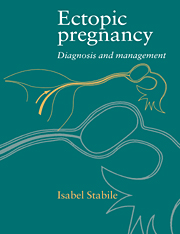Book contents
- Frontmatter
- Contents
- 1 Incidence, aetiology and pathophysiology of ectopic pregnancy
- 2 Clinical presentation of ectopic pregnancy
- 3 Biochemical diagnosis of ectopic pregnancy
- 4 Ultrasound diagnosis of ectopic pregnancy
- 5 Surgical diagnosis
- 6 Practical management of suspected ectopic pregnancy
- 7 Extratubal and unusual ectopic pregnancies
- 8 Medical treatment of ectopic pregnancy
- 9 Conservative and expectant management of ectopic pregnancy
- 10 Radical surgery
- 11 Pregnancy after ectopic pregnancy
- Epilogue: the future
- Index
2 - Clinical presentation of ectopic pregnancy
Published online by Cambridge University Press: 26 March 2010
- Frontmatter
- Contents
- 1 Incidence, aetiology and pathophysiology of ectopic pregnancy
- 2 Clinical presentation of ectopic pregnancy
- 3 Biochemical diagnosis of ectopic pregnancy
- 4 Ultrasound diagnosis of ectopic pregnancy
- 5 Surgical diagnosis
- 6 Practical management of suspected ectopic pregnancy
- 7 Extratubal and unusual ectopic pregnancies
- 8 Medical treatment of ectopic pregnancy
- 9 Conservative and expectant management of ectopic pregnancy
- 10 Radical surgery
- 11 Pregnancy after ectopic pregnancy
- Epilogue: the future
- Index
Summary
Introduction
Ectopic pregnancy remains the great mimic of gynaecology; no other pelvic condition gives rise to more diagnostic errors. The patient may or may not have symptoms pointing to pregnancy. With or without a period of amenorrhoea she typically complains of pelvic pain and irregular vaginal bleeding, but whereas the picture is so characteristic when set down in writing, it is often difficult at the bedside to appreciate the significance of these symptoms. Indeed, only half of the patients with ectopic pregnancy will be correctly diagnosed as having the condition on the basis of clinical features alone (Tuomivaara et al., 1986). The vaginal bleeding is often attributed to a delayed menstrual period or threatened abortion and the pain, if slight, to intestinal colic, whereas tiredness and nausea, if present, are considered to be the ordinary discomforts of a normal pregnancy. In rare cases there are no clinical features to raise suspicion at all. Often the differential diagnosis lies between tubal pregnancy, a normal intrauterine pregnancy with a small ovarian cyst and a threatened, recent or ongoing miscarriage, sometimes in a patient with salpingo-oophoritis.
Symptomatology
Abdominal pain is the commonest symptom, often present even prior to rupture, but there is little or no correlation between the nature, distribution and radiation of the pain and the final diagnosis. It is entirely a matter of chance how frequent are these attacks of pain prior to tubal abortion or rupture.
- Type
- Chapter
- Information
- Ectopic PregnancyDiagnosis and Management, pp. 14 - 20Publisher: Cambridge University PressPrint publication year: 1996



